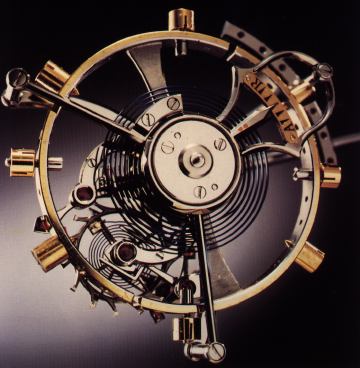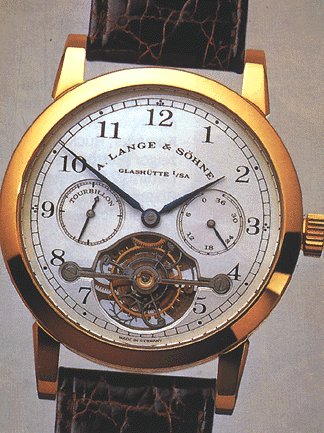How to buy a new watch...some guidelines

The tourbillon escape. One of the
greatest horological marvels. Invented by Abraham Louis Breguet, it
allows the entire escape and balance to rotate on its
own axis to even out the effects of gravity
When I first started this hobby, I could hardly find any information on
how to evaluate and buy a watch. I was often at the mercy of watch
salespeople, who had other agenda in their mind.
To help a novice watch collector begin this exciting hobby, I decided
to create a "How To" page to guide the novice. Use this as a guideline to
begin your journey. As you progress, you will learn a lot, and I hope
enjoy the hobby.
| |
Step 1
Frequent newsgroups and forums and
follow the discussion for weeks or months. Read the FAQs. After a week or
so, you would be able to identify some of the resident gurus. Email them,
but ask specific questions.
Observe which makes and models are netters passionate with. Understand
why. Note which makes and models to avoid. Post your own questions at
these forums. If you have never participated in forums, you may be
pleasantly surprised by the volume information you will get. But do remember
the adage: "Free advice is worth what you pay for".
Use the information and advice (including information from pages like
this one) only as a means to help you narrow down the choices of which
watch to look at. Never let anybody else decide for you what to buy,
especially not the salesperson, not passionate netters. Use the input
as data points.
Don't worry too much about technical details, like the beat of the
escape, the number of rubies etc. These are important issues, but not
at this stage. Your participation in the groups will help you understand
these and more.
Step 2: Go to your local authorized retailer.
After you have narrowed down the recommendations, go to your local
retailer, and ask to see those 3 or 4 watches. This is important. Don't
see more each time, or it will confuse you. This is kinda like tasting
wine or buying perfume. Your brain will overload...unless you are some
alien lifeform with significantly greater cerebral capacity.
An authorized dealer is important. If you can find one who is
knowledgable, ethical in your vicinity, support him well.
Step 3: In the shop.
Always put it on your wrist. Does it give you an emotional pull? A
watch must bring you pleasure. Otherwise don't buy it. Everything should
feel right. The bracelet or the band should be comfortable, the watch case
should look right on your wrist.
Of course the more expensive the watch, the more fussy you should be.
If it doesn't feel right on your wrist perhaps you shouldn't buy it...or
should consider another hobby.
Wind it, with some crowns, you will need to unscrew them first. Briskly
wind the crown until the watch starts, usually about 10 or 12 turns of the
crown. Stop if you feel any resistance.
Feel how it winds. Winding tells how the winding system is
finished inside. The smoother the better. Ask before you wind it, some
salespeople may not be happy if you handle the watch. If this happens,
thank them and leave immediately. Never go back to the shop. Either they
don't understand watches (which is surprisingly quite common, even in very
large stores) or they don't care (worst).
|
Ask to borrow their x5 loupe (or invest in one. I have found that
everytime I bring out my own loupe, the retailer ALWAYS raise an eyebrow
and increases his respect while decreasing his bullshit...the latter is
important, the former merely boosts my ego) and look at the movement
(if it has a display back), at the dial, at the case, at the horns.
See how it is finished. Finishing is everything in a luxury watch. All
surfaces should be well polished, and all edges should be bevelled and
polished. Any obvious errors like smearing in the printing, misaligned
hands (this is surprisingly common...don't accept such shoddy workmanship)
etc.
| 
One of the best finished watches
in existance: The Lange tourbillon
|
Here is a primer on how to judge the finish of a
movement, and an example.
Step 3: Buy it
If you can afford it without having to mortgage anything, and you
like it, buy it. "Like it" is the operative word. You must like it.
Watches are not investments. If you are looking for good returns for your
money try the stock market, or buy real estate, put it in a bank.
Some watches do increase in value over time, but don't count on it. That way,
if it increases in value, good for you. Otherwise, enjoy the watch. The
only way to be sure you can make a small fortune out of watch collecting
is to start with a large one.
Step 4: Absolutely critical!
Then this is the most important step: enjoy the watch. Don't care
what anybody else, or an expert tells you. If a Swatch is what it takes
to make your day, buy a Swatch...make that a mechanical Swatch, if you are
considering buying a quartz watch, ignore everything you have read here and
look elsewhere for advice.
Closing remarks
Here are some watches you can look at to begin. Oris, Revue Thommen
and Omega makes fine entry level watches. Eberhard, Daniel JeanRichards, Minerva carry excellent examples, perhaps one level up. This list is by no means complete.
I would recommend you to seek them out and follow Steps 2. After you
have completed Step 2, and don't like what they offer, you are looking at
spending real money. Click here to see some
interesting watches.
Wellcome to the hobby. It is an interesting one...here is one man's
humerous view of it.
He calls it Mycroft's Syndrome

Take me home
This page was created by Peter Chong. Last updated January 11, 1998. And has been accessed  times since Dec 22, 98.
times since Dec 22, 98.

